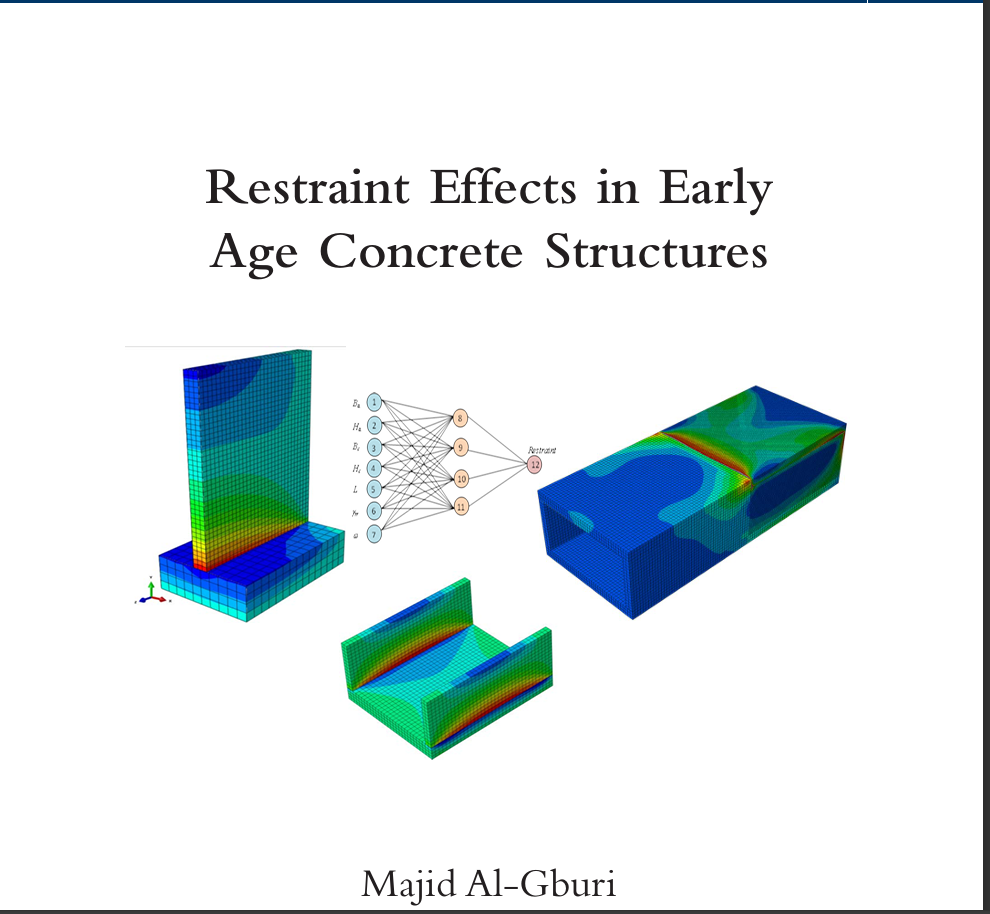
Research Interests
Young concrete
Restraint
Early age Cracks
Neural networks
concrete cracks
| Gender | MALE |
|---|---|
| Place of Work | Technical Engineering College/ Mosul |
| Position | |
| Qualification | |
| Speciality | |
| majid.algburi@ntu.edu.iq | |
| Phone | 07763444002 |
| Address | Al-Yarmook, Mosul, Mosul, Iraq |

Publications
Artificial Neural Network Model for Evaluating Load Capacity of RC Deep Beams
Mar 27, 2025Journal Buildings
publisher MDPI
DOI https://doi.org/10.3390/buildings15081371
Issue 8
Volume 15
The effect of real curing temperatures on early age concrete strength development in massive concrete structures
Feb 20, 2025Journal European Journal of Environmental and Civil Engineering
publisher Taylor Francis
DOI https://doi.org/10.1080/19648189.2025.2458294
Issue 9
Volume 29
Evaluation of Physical and Mechanical Properties of Modified Cement-Lime Mortar Containing Recycled Granite Powder Waste as a Partial Fine Aggregate Replacement
Nov 6, 2024Journal Applied Scinces
publisher MDPI
DOI https://doi.org/10.3390/app142210146
Issue 22
Volume 14
first_pagesettingsOrder Article Reprints Open AccessArticle Evaluation of Physical and Mechanical Properties of Modified Cement-Lime Mortar Containing Recycled Granite Powder Waste as a Partial Fine Aggregate Replacement by Jasim Mohammed Abed 1ORCID,Majid Al-Gburi 1 andAsaad Almssad 2,*ORCID 1 Building and Construction Techniques Engineering Department, Northern Technical University, Mosul 41002, Iraq 2 Department of Engineering and Chemical Sciences, Karlstad University, 651 88 Karlstad, Sweden * Author to whom correspondence should be addressed. Appl. Sci. 2024, 14(22), 10146; https://doi.org/10.3390/app142210146 Submission received: 5 September 2024 / Revised: 27 September 2024 / Accepted: 22 October 2024 / Published: 6 November 2024 (This article belongs to the Special Issue Concrete and Climate: Engineering Low-Carbon Solutions for the Building Sector) Downloadkeyboard_arrow_down Browse Figures Review Reports Versions Notes Abstract This study aims to incorporate building and demolition waste, including lime and crushed granite, as partial alternatives for cement and fine aggregates, respectively, and to devise a plan to reduce their environmental effect resulting from their extensive prevalence in substantial amounts. The use of lime in paste, mortar, and concrete has become a common practice to regulate the environment, save resources, and improve performance in various settings. The first stage of this study investigated the effects of replacing different proportions (0%, 15%, 25%, 35%, and 50%) of lime powder with cement on the physical and mechanical properties of mortar specimens over 7, 28, and 90 days. The next phase of the research examined the impacts of substituting varying quantities (ranging from 10% to 100%) of granite powder in 15 different mixes, while keeping a consistent water-to-binder ratio of 0.45. The last part of the study consisted of an examination of data from previous research on cement mortar and lime-modified cement mortar. This included testing on flowability, standard consistency, setting time, flexural strength, and compressive strength. The acquired data underwent a statistical analysis, which resulted in the development of equations that may predict the mechanical characteristics of changed cement mortar mixes. These equations also highlight the impact of certain physical qualities on compressive and flexural strength.
Evaluating Concrete Strength Under Various Curing Conditions Using Artificial Neural Networks
Jul 23, 2024Journal Nordic Concrete Research
publisher Nordic Concrete Federation
DOI https://doi.org/10.2478/ncr-2024-0007
Issue 2
Volume 71
This study examines the impact of different curing methods on the compressive strength of concrete. It investigates techniques such as air curing, periodic water spraying, full water submersion, and polyethylene encasement. Artificial neural network models were employed to evaluate the compressive strength under each curing condition. A model for calculating compressive strength that considers surrounding conditions was created using an artificial neural network. The current study’s figures were generated using this model. The research thoroughly examined the impact of curing environments and concrete mix components on strength properties, taking into account factors such as temperature, the inclusion of additives such as fly ash and silica fume, adjustments in water-to-cement ratio, selection of aggregates, and the integration of various admixtures. One important discovery is that models that predict compressive strength based on 28-day water immersion do not accurately represent the actual strength because of the substantial impact of local curing conditions. Furthermore, concrete that was cured in polyethylene bags exhibited noticeable differences in moisture retention and temperature properties when compared to alternative methods. Understanding and evaluating curing conditions is crucial for accurate strength predictions. The study also found that compressive strength decreases with temperatures above 30°C and below 15°C.
Utilization of Nanoparticles and Waste Materials in Cement Mortars
Sep 19, 2023Journal Journal of the Mechanical Behavior of Materials
publisher Walter de Gruyter
DOI https://doi.org/10.1515/jmbm-2022-0289
Issue 1
Volume 32
Cement has shaped the modern built environment, but its production generates substantial carbon dioxide emissions. Consequently, there is an urgent need to identify alternative cementitious building materials for sustainable construction. In this study, cement mortars (CMs) were produced by partially replacing cement with nanoclay (NC) and granite dust (GD). The replacement proportions (% by weight of cement) of these materials were 1.5, 3, and 4.5% for NC and 10, 20, and 30% for GD. For mortars containing NC but not GD, the strength was maximized when the NC replacement proportion was 3%. To evaluate the combined effect of partially replacing cement with both NC and GD on the fresh and hardening properties of cement-blended mortars, ternary binder mixtures containing 3% NC together with 10, 20, or 30% GD were prepared, and their workability, bulk density, compressive strength (at 7, 28, and 90 days), and flexural strength were measured. Increasing the content of NC and/or GD reduced the flowability of these mortars relative to that of the reference mortar mix because it increased the content of fine materials. CM containing 3% NC and 10% GD had the highest compressive strength at 7, 28, and 90 days while also having the greatest flexural strength when compared to the control mix. This is most likely due to the high silica and alumina content of NC and GD, as well as their high specific surface area, which would improve the maturity and density of the matrix when compared to cement alone.
Structural Behavior of Reinforced Lightweight Self-compacting Concrete Beams using EPS as Coarse Aggregate and containing PET Fibers
Jun 13, 2023Journal Structural Concrete Fib
publisher WILEY
DOI https://doi.org/10.1515/jmbm-2022-0289
Issue 5
Volume 24
Through this study, an attempt was made to produce concrete beams from self-compacting concrete (SCC) contain expanded polystyrene (EPS) beads as coarse aggregate and waste plastic fibers (WPFs) produced from cutting disposed packing straps in site. The beams were designed according to ACI-318-14, where three different reinforcement ratios were chosen for the purpose of checking the conductance of thresholds made of this type of environmentally friendly concrete under bending loads. The use of EPS with WPFs had a significant positive effect in reducing the density of concrete, and the highest percentage of reduction was equal to (38.46%). Using WPFs had a positive effect in increasing the flexural toughness of concrete prisms, and the maximum increment was equal to (180%) compared with these made from the reference mix. The results proved the possibility of producing lightweight concrete from the use of EPS waste and WPFs, three of which are structurally can be classified as lightweight concrete combination of normal weight and lightweight aggregates according to specifications requirements of ASTM330/330M-14. Reinforced lightweight SCC beams behaved under flexural loads similar to the reinforced concrete beams made from normal weight concrete counterparts under flexural loads.
Utilization of Hybrid Fibers in Different Types of Concrete and Their Activity
Feb 2, 2023Journal Journal of the Mechanical Behavior of Materials
publisher Walter de Gruyter
DOI https://doi.org/10.1515/jmbm-2022-0262
Issue 1
Volume 32
Utilization of Hybrid Fibers in Different Types of Concrete and Their Activity
Feb 2, 2023Journal Journal of the Mechanical Behavior of Materials
publisher Walter de Gruyter
DOI https://doi.org/10.1515/jmbm-2022-0262
Issue 1
Volume 32
3D FE Modelling of Cable-Stayed Bridge According to ICE Code
Dec 31, 2022Journal Open Engineering
publisher Walter de Gruyter
DOI https://doi.org/10.1515/jmbm-2022-0262
Issue 1
Volume 12
This article presents the performance of cable-stayed bridge by representing a model using the ANSYS program under the influence of a concentrated load and then comparing them with the experimental results. One model was used in the analytical, and one was (harp type 1) used in the length of the girder (4,500 mm), height of the pylon (1,480 mm), and depth of the flange for the girder (40 mm). If cable-stayed bridges are constructed using the balanced cantilever method, the stability problem of the girder is more significant during the construction stage than at the initial state. In this study, to investigate the ultimate behavior of cable-stayed bridges, experimental and analytical studies were conducted for one model: Harp type 1. At the limit state, several plastic hinges occurred and the girders buckle along the entire span. Numerical analysis was conducted for the experimental model, and the results of which showed good agreement with the experimental results. The influence of such kind of effects on the analysis and the structural behavior of cable-stayed bridges has been examined in detail in the study. The dimensions of the model were also compared with institute civil engineering Code in terms of the height of the tower to the main space, and Back Span to the main span ratio. It was close to standard specifications. A finite element procedure for the nonlinear analysis of cable-stayed bridges is first set up, and then, a detailed static deflection analysis of such bridges is carried out.
Reducing Thermal Crack Risks Caused by Restraint in Young Concrete - A Case Study on Walls of Water Tanks
Jul 1, 2022Journal Nordic Concrete Research
publisher Nordic Concrete Federation
DOI https://doi.org/10.2478/ncr-2022-0001
Issue 1
Volume 66
Concrete cracks in structures such as water tanks and nuclear power stations cause anxiety to owners, contractors and engineers. These cracks may significantly increase the structure’s permeability and thus increase leakage, reduce durability, and eventually lead to loss of structural functionality. Therefore it is important to minimize their occurrence and size. To identify effective ways of minimizing cracking in young concrete segments, a parametric study was conducted using the finite element method (FEM). Parameters considered include casting sequence, joint position, wall height, and cooling. The study examined continuous and jumped casting approaches to the casting of a cylindrical reinforced concrete tank for a sewage-treatment plant, with and without the application of the ‘kicker’ technique in which the lower part of the wall is cast with the slab. The main cause of cracking is thermal change and restraint imposed by adjacent older structures, and the FEM predictions agree well with experimental observations. Continuous casting is most effective at minimizing cracking because it creates only two contact edges between newly cast and existing structures producing the lowest level of restraint. The kicker technique is shown to be very effective for reducing restraint and consider rephasing
Investigate the effect of mineral additives on concrete strength using ANN,
Mar 11, 2022Journal Asian Journal of Civil Engineering
publisher Springer
DOI https://doi.org/10.2478/ncr-2022-0001
Issue 1
Volume 23
In addition to cement, sand, gravel, and water, the current investigation of the influence of additives on the compressive strength of concrete at 28 days includes fly ash, silica fume, and slag. 315 concrete compositions with various amounts of additives are trained and tested using an artificial neural network. Concrete strength is largely affected by the specific gravity of cement and the specific gravity of fine and coarse particles, according to the studies. For greater compressive strength, it is preferable to use materials with a higher specific gravity. Compressive strength has grown as the amount of silica fumes has increased. Increased amounts of slag or superplasticizer resulted in the same behavior. When the amount of fly ash was increased, the compressive strength of the material decreased.






